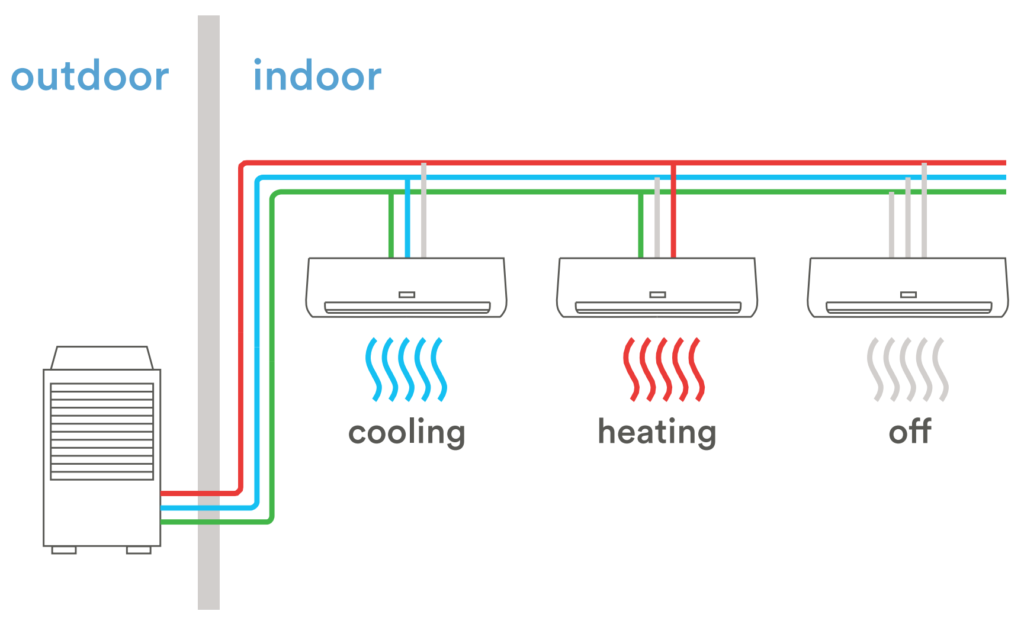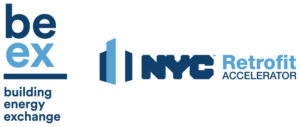Variable Refrigerant Flow (VRF)
Variable Refrigerant Flow Systems are highly efficient heat pumps for centralized electric heating and cooling in multifamily buildings.
Tech Overview
Applicable Buildings Types all multifamily, hotels
When to Implement at time of equipment replacement
*Be sure to consult a qualified service provider to determine the right measures for your building.
What is a VRF System?
Variable Refrigerant Flow (VRF) is an air-source heat pump (ASHP) technology that can be used to heat and cool multifamily buildings on the path to electrification. A VFR system is an efficient heating and cooling technology that saves energy and reduces greenhouse gas emissions while greatly improving resident comfort.

Fig 1. Multiple indoor units, serving a single floor or a vertical stack, are connected to one outdoor unit via refrigerant lines. Below is a VRF system with heat recovery, which allows different parts of the building to be heated or cooled simultaneously. This requires a third refrigerant lines and additional controls.
How to Implement
Due to high cost of replacing heating and cooling systems, the best time to consider this upgrade is during a major renovation or at the time of equipment replacement. Download the full tech primer to learn more about each of the following steps:
A. Plan how the refrigerant lines will run through the building and if and how the building should be divided into heating and cooling zones
B. Determine Unit Location for outdoor units on the roof or at the ground level and indoor units serving one or multiple rooms
C. Install a VRF system with the help of qualified contractors to avoid refrigerant leaks and an under-performing system due to poor installation
Cost and Benefits
Cost and benefits of Variable Refrigerant Flow (VFR) systems will vary depending on your building’s baseline systems and conditions. Typically, buildings can expect to see the following results:
Greenhouse Gas (GHG) Savings
Converting a multifamily building to a VRF system can greatly reduce heating and cooling related GHG emissions.
Tenant Experience Improvement
VRF systems dramatically improve tenant satisfaction by delivering quiet, uniform heating and cooling adjustable to personal comfort preferences.
Utility Savings
Although VRF systems consume significantly less energy than systems that use natural gas, fuel oil, or district steam, utility cost for operating a VRF system can be high due to the current cost of electricity.
Capital Cost
The capital cost for a VRF system conversions are high due to the number of units required to fulfill individual space temperature preferences. Cost savings possibilities are available.
Maintenance Requirement
A properly installed VRF system requires a low level of maintenance involving cleaning air filters and monitoring for refrigerant leakage within the first year of installation.
Take Action
This information is part of more than a dozen High Performance Technology Primers prepared by the Building Energy Exchange and the Retrofit Accelerator to introduce decision-makers to solutions that can help them save energy and improve comfort in their buildings. Curious about other retrofitting possibilities? Explore our complete library of Tech Primers here.
The NYC Retrofit Accelerator’s team of Efficiency Advisors offers free, personalized advisory services to help streamline the process of making energy efficient improvements to your buildings.
Get in touch with the NYC Retrofit Accelerator today!
Call (212) 656-9202
Visit nyc.gov/RetrofitAccelerator
Email info @nycretrofit.org
